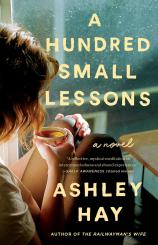Reading Group Guide
Discussion Questions
A Hundred Small Lessons

1. In the Michael Ondaatje poem, we see the titular phrase “a hundred small lessons” (ch. 12), describing children dreaming of their past lives. How does this idea of dreaming and learning from our previous incarnations relate to the major themes of the book? What are some of the “small lessons” you see in this novel?
2. Early on, Lucy notes that she usually has no difficulty adjusting to new places when she has moved for Ben’s work. Why does it take so much longer for her to feel at home in Brisbane? What are some of the factors that make this transition different, and why do these distinctions have such an impact on Lucy?
3. Lucy is fascinated by the idea of vardøgers, imagining her “other selves” and attributing things she can’t explain to their actions. What are some moments throughout the book that don’t explicitly mention the concept of vardøgers but evoke the same idea? Pick a couple examples from Lucy’s perspective and a couple from another perspective, and discuss what these seem to signify.
4. Birds have been thought to portend good or bad luck and foretell the future in many cultures throughout history. Elsie believes that the disappearance of the baby crow she saw in the yard is “the reason she and Clem had had no more children” (ch. 6). Do any of the other birds that appear in the book strike you as omens? If so, what do you think they signify?
5. The epigraph at the beginning of the novel quotes from a poem by John Burnside titled “III. De Libero Arbitrio,” in reference to a book on free will written by the fourth-century bishop Augustine of Hippo. Now that you’ve read A HUNDRED SMALL LESSONS, reread the epigraph. Why do you think Ashley Hay selected this poem? How might it inform your reading of the novel?
6. Both Elsie and Lucy become stay-at-home mothers after the birth of their children. Compare and contrast their relationships to motherhood. In what respects does having a child impact them in similar ways, and how and why do their experiences of raising their children diverge?
7. Elaine and Elsie have a difficult relationship, in part because of their differing opinions about what constitutes success and fulfillment in life. What do these concepts mean to you? Consider the various characters throughout the book --- Lucy, Ben, Elsie, Clem, Elaine, Donny, Richard and Ida Lewis, etc. What assumptions about their happiness or sense of achievement might you make if you came across them in real life? How do these compare with what the characters themselves express over the course of the novel?
8. In chapter 13, Elsie first sees her portrait by Ida Lewis. Were you surprised by how she reacted to the painting? What do you think she was hoping for, prior to seeing it? Do you think she was disappointed? Why, or why not? What do you think her relationship with Ida meant to her, and why did she decide not to continue to see her?
9. While preparing for her wedding, Elaine says “I thought there’d be more to it than this” (ch. 4). After a moment, Elsie responds, interpreting “it” as a reference to Elaine’s bouquet. Later, Elsie recalls this moment, thinking “I’d never before thought [Elaine] was greedy” (ch. 6). How did you understand this scene as it transpired? What were Elaine and Elsie really saying to each other? Do you think Elsie’s recollection of that moment changed over time?
10. The last chapter is titled “Lucy’s house.” At what point did you feel it became “Lucy’s house,” after long being thought of by Lucy herself as Elsie’s house? What are some things you do to make a space yours when you move somewhere new?
11. Elsie laments that Elaine and her daughter Gloria “never found a way to be friends” (ch. 2), and later wonders aloud if she and Elaine were ever friends. Do you think it’s important for family members, specifically mothers and daughters, to be friends? Discuss the different expressions of love we see throughout the book and the role of emotional intimacy in the many familial relationships. Are love and emotional intimacy the same thing? Why, or why not?
Enhance Your Book Club
1. Lucy spends much of the book fantasizing about who Elsie is and what her life in the house was like. Consider your own home, and imagine either its past or future tenants. Who are they? How might they feel about their home? Write a short story envisioning a scene from their lives in your home, and share with your reading group.
2. Lucy and Elsie both must confront a flood endangering the same home, and must contemplate the way their possessions and the memories and significance they represent could be suddenly washed away. What would you grab from your home if you could only take what you can carry? If possible, bring one of these items to your reading group, and share why you chose it.
3. Check out Ashley Hay’s other novels, THE BODY IN THE CLOUDS and THE RAILWAYMAN'S WIFE. To find out more about Ashley, visit www.ashleyhay.com.au, or follow her on Facebook at www.facebook.com/ashleyhaywriter.
A Hundred Small Lessons
- Publication Date: September 18, 2018
- Genres: Fiction, Women's Fiction
- Paperback: 304 pages
- Publisher: Washington Square Press
- ISBN-10: 1501165143
- ISBN-13: 9781501165146







